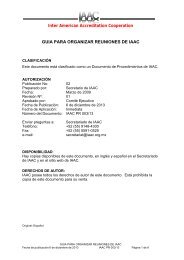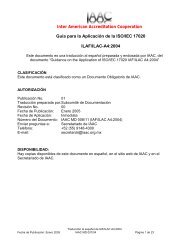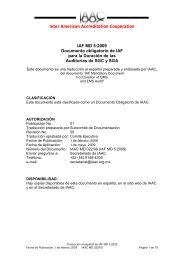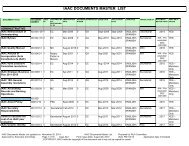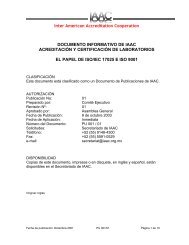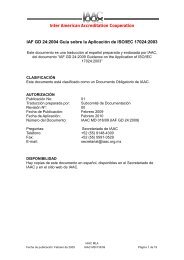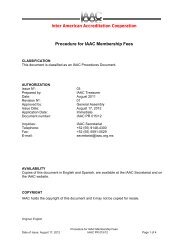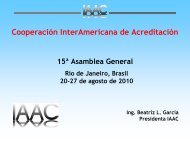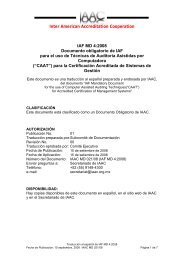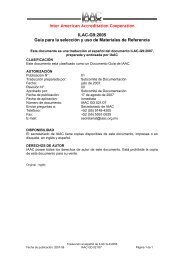IAAC GA Open Seminar
IAAC GA Open Seminar
IAAC GA Open Seminar
You also want an ePaper? Increase the reach of your titles
YUMPU automatically turns print PDFs into web optimized ePapers that Google loves.
<strong>IAAC</strong> 12 th General Assembly<br />
Ottawa, CANADA / August 11-19, 2007<br />
While not unique, several examples were mentioned of Canada’s efforts to improve its<br />
accreditation programs. These include the importance of reading and understanding the<br />
marketplace, and of accreditation bodies understanding their own strengths and weaknesses.<br />
In Canada, this led the SCC and others to collaborate and design new program structures such<br />
as joint partnerships or multiple-stakeholder efforts in respect to various regulatory needs at the<br />
federal and provincial levels.<br />
Included in the new structures were new features, in some cases custom-designed to enhance<br />
flexibility. Again, the one-window approach to accreditation that involves grouping specialties<br />
under broader scopes for accreditation results in better service to multiple clients, and/or to<br />
multiple programs held within individual client portfolios.<br />
Another example is simply taking the initiative as opportunities arise. This happened in the<br />
case of forensics science and its expansion since 1994 when a WG was first established by the<br />
Canadian Society of Forensic Science; this entailed responding to new Canadian DNA databank<br />
legislation to provide support and assurances of adherence to accepted practices and standards<br />
and provision of proper and credible documentation on test methods, results, reporting and expert<br />
testimony.<br />
Future for accreditation<br />
To be more effective in the future, accreditation bodies need to clearly define and agree on a<br />
definition of purpose and use. One observation is that accreditation bodies need to do much<br />
more to clarify and promote the distinction and value of accreditation, as a tool, over certification.<br />
A suggestion was that this could be supplemented by improving understanding of the varying<br />
value equations for accreditation across sectors, and possibly across economies and regions.<br />
More promotion and continued development of regional and global networks were stressed as<br />
important and beneficial over time at the international level. In addition, involvement of users<br />
from industry; possible reciprocity arrangements among regulatory bodies; more focus on scoping<br />
and other technical issues; plus more support for mutual recognition schemes were felt to be<br />
important. Some countries not yet at the level of recognition are looking for short-term strategies<br />
to improve industry relationships and expressed interest in the Canadian approach of early<br />
inclusiveness, transparency and multi-stakeholder decision-making.<br />
The emergence of supplier declarations was raised as a potential threat to accreditation. Various<br />
discussions, for example, in Europe or at multi-lateral bodies like the Organization for Economic<br />
Cooperation and Development (OECD) and the Technical Barriers to Trade Committee (TBT) of<br />
the World Trade Organization (WTO) were noted by participants. Certain clarifications or updates<br />
on the status of these activities were provided to enhance current understanding and<br />
comprehension of participants. Nonetheless, shared concerns remained, in particular about<br />
product safety issues and the credibility of supplier assertions.<br />
Various stakeholders are now asking accreditation bodies to remain or get involved in these<br />
developments and discussions. There is also a challenge from some parties to encourage<br />
accreditation bodies to consider countering the declaration proponents and actions. At the same<br />
time, there is need for some accreditation bodies to embrace more open competition in markets<br />
and to remove their monopolies in some sectors, or in some regions.<br />
In Canada, it was felt that the future could bring demands in the private sector for more diversity<br />
of action and more service competition. This could result in greater segmentation of accreditation<br />
clients. In certain sectors, there could be more emphasis on supply chain competencies in more<br />
4



